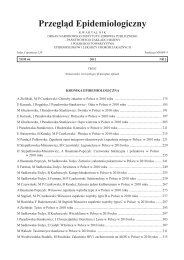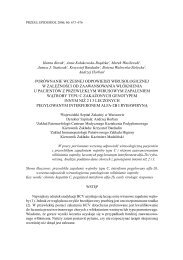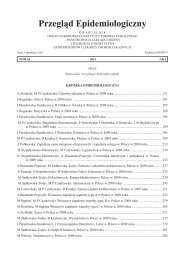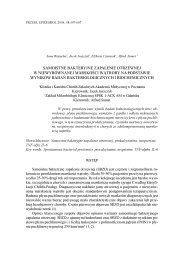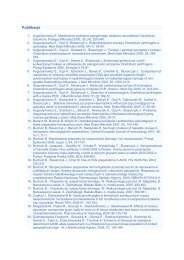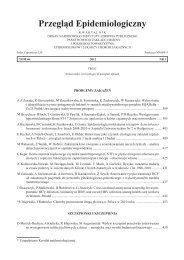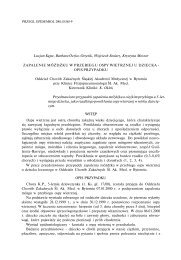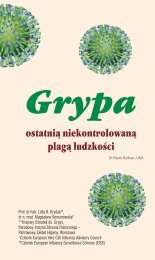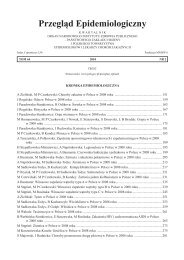12 Piotr Grabarczyk, Jolanta Korzeniowska i inniNr 1przewlekłe zakażenie B19V bez żadnych objawów klinicznychi laboratoryjnych przez ponad trzy lata i trzymiesiące. Zaniżenie wyniku ilościowego o dwa rzędywielkości metodą stosowaną w II okresie badań B19Vwskazuje na słuszność przyjętej strategii badań B19Vw pojedynczej donacji i odsuwania od oddawania krwidawców, u których stwierdzono B19V.PIŚMIENNICTWO1. Young NS, Brown KE. Mechanisms of disease. ParvovirusB19. N Engl J Med 2004; 350(6): 586-596.2. Parsyan A, Candotti D. Human erythrovirus B19 andblood transfusion - an update. Transfus Med. 2007; 17(4):263-278.3. de Jong EP, de Haan TR, Kroes ACM, Beersma MFC,Oepkes D, Walther FJ. Parvovirus B19 infection in pregnancy.J Clin Virol 2006; 36: 1–7.4. Wąsak-Szulkowska E, Grabarczyk P, Rzepecki P. Purered cell aplasia due to parvovirus B19 infection transmittedprobably through hematopoietic stem cell transplantation.Transpl Infect Dis 2008, 10: 201-205.5. Yango A Jr, Morrissey P, Gohh R, Wahbeh A. Donor--transmitted parvovirus infection in a kidney transplantrecipient presenting as pancytopenia and allograft dysfunction.Transpl Infect Dis 2002, 4:163-166.6. Brojer E, Grabarczyk P, Łopaciuk S, Moraczewska Z,Żupańska B. Prevalence of human parvovirus B19 DNAand IgG/IgM antibodies in Polish haemophilia patients.Vox Sang 1999, 77: 107.7. Łętowska M. [red.] Medyczne zasady pobierania krwi,oddzielania jej składników i wydawania, obowiązującew jednostkach organizacyjnych publicznej służby krwi,IHiT, Warszawa 2006 (wersja 4, 2010).8. Aberham C, Pendl C, Gross P, Zerlauth G, Gessner M.A quantitative, internally controlled real-time PCR assayfor the detection of parvovirus B19 DNA. J VirolMethods 2001; 92: 183-191.9. Kwok S, Higuchi R. Avoiding false positives with PCR.Nature 1989, 339: 237-238.10. Grabarczyk P, Kalińska A, Kara M, Wieczorek R, HejdukA, Sulkowska E, Michalak M, Gołębiowska-StaroszczykS, Baylis SA, Brojer E. Identification and characterizationof Parvovirus B19 genotype 2 acute infection inimmunocompromised patients in Poland. J Med Virol2011, 83 (1): 142-149.11. Grabarczyk P, Kalińska A, Sulkowska E, Brojer E. Falsenegative results in high viremia Parvovirus B19-samplestested with real-time PCR. Polish J Microbiol 2010, 59,2: 129-132.12. Siennicka J, Stefanoff P, Trzcińska A, Rosińska M,Litwińska B Seroprevalence study of parvovirus B19 inPoland. Przegl Epidemiol 2006; 60(3): 571-580.13. Mossong J, Hens N, Friederichs V i wsp. Parvovirus B19infection in five European countries: seroepidemiology,force of infection and maternal risk of infection. EpidemiolInfect 2008; 136: 1059-1068.14. Oszukowski P, Małafiej E, Pertyński T i wsp. Infectionwith parvovirus B19 in pregnant women. Ginekol Pol1996; 67(3): 114-116.15. Lenkiewicz B, Roszkowski T, Grabarczyk P i wsp. Diagnosisof human parvovirus B19 infection in nonimmunehydrops fetalis. Ginekol. Pol. 1998; 69(4): 175-181.16. Gessoni G, Barin P, Marchiori G. Nucleic acid amplificationtechnique (NAT) screening for parvovirus B19:the first Italia routine experience. Transf Med 2007, 17,417-419.17. Kleinman SH, Glynn SA, Lee T-H, Cobler L, MontalvoL, Todd D, Kiss JE, Shyamala V, Busch MP. Prevalenceand quantitation of parvovirus B19 DNA level in blooddonors with sensitive polymerase chain reaction screeningassay. Transfusion 2007, 47: 1756-1764.18. Schmidt M, Themann A, Drexler C, Bayer M, Lanzer G,Menichetti E, Lechner S, Wessin D, Prokoph B, AllainJP, Seifried E, Hourfar MK. Blood donor screening forparvovirus B19 in Germany and Austria. Transfusion2007; 47 (10): 1775-1782.19. Candotti D, Etiz N, Parsyan A, Allain J-P. Identificationand characterization of persistent human erythrovirus infectionin blood donor samples. J Virology 2004; 78(22):12169-12178.20. Lefrere JJ, Servant-Delmas A, Candotti D, Mariotti M,Thomas I, Brossard Y, Lefrere F, Girot R, Allain JP, LapercheS. Persistent B19 infection in immunocompetentindividuals: Implications for transfusion safety. Blood2005, 15: 2890–2895.21. Servant A, Laperche S, Lallemand F, Marinho V, DeSaint Maur G, Meritet JR, Garbarg-Chenon A. Geneticdiversity within human erythroviruses: Identification ofthree genotypes. J Virol 2002, 76: 9124–9134.22. Baylis SA, Buchheit KH. A proficiency testing studyto evaluate laboratory performance for the detection ofdifferent genotypes of parvovirus B19. Vox Sang 2009;97(1): 13-20.23. Baylis SA, Fryer JF, Grabarczyk P. Effect of probe bindingmutations in an assay design to detect parvovirusB19: Implications for the quantitation of different virusgenotype. J Virol Methods 2007; 139: 97–99.24. Schneider B, Becker M, Brackmann H-H, Eis-HűbingerAM. Contamination of coagulation factor concentrateswith human parvovirus B19 genotype 1 and 2. ThrombHaemost 2004; 92: 838-845.Otrzymano: 29.09.2011 r.Zaakceptowano do druku: 15.11.2011 r.Adres do korespondencji:Dr Piotr Grabarczyk,Zakład WirusologiiInstytut Hematologii i Transfuzjologii,ul. Chocimska 5, 00-957 Warszawa,e-mail: pgrabarczyk@ihit.waw.pltel. 22 349 66 00 wewn. 144
PRZEGL EPIDEMIOL 2012; 66: 13 - 18Prolbemy zakażeńPatrycja Zalas-Więcek, Eugenia Gospodarek, Joanna WróblewskaWYSTĘPOWANIE ORAZ LEKOWRAŻLIWOŚĆ SZCZEPÓW MORGANELLAMORGANII IZOLOWANYCH Z MATERIAŁU KLINICZNEGOOCCURRENCE AND ANTIMICROBIAL SUSCEPTIBILITY OF MORGANELLAMORGANII STRAINS ISOLATED FROM CLINICAL SAMPLESKatedra i Zakład Mikrobiologii Collegium Medicum im. Ludwika Rydygiera w BydgoszczyUniwersytetu Mikołaja Kopernika w ToruniuSTRESZCZENIECelem pracy była retrospektywna ocena występowaniaoraz lekowrażliwości pałeczek Morganella morganiiizolowanych z materiału klinicznego. Badaniem objęto201 szczepów wyosobnionych w latach 2008-2010w Szpitalu Uniwersyteckim nr 1 im. dr. A. JuraszaCollegium Medicum im. L. Rydygiera w Bydgoszczy,Uniwersytetu Mikołaja Kopernika w Toruniu. Identyfikacjędo gatunku prowadzono na podstawie reakcjibiochemicznych ujętych w testach ID 32E i kartachGN VITEK2. Wrażliwość pałeczek M. morganii naantybiotyki oznaczano metodą krążkowo-dyfuzyjnąna podłożu Mueller-Hinton II Agar. Szczepy M. morganiinajczęściej izolowano z zakażeń skóry i tkanekmiękkich oraz materiału pobranego z dróg moczowych,głównie od chorych Kliniki Anestezjologii i IntensywnejTerapii, Kliniki Chirurgii Ogólnej i Naczyń oraz KlinikiChirurgii Ogólnej i Endokrynologicznej. Wszystkieszczepy M. morganii izolowane w okresie trzech lat byływrażliwe na karbapenemy. Notowano spadek odsetkaszczepów wrażliwych na piperacylinę i chloramfenikol.W 2010 roku wykazano wyższy odsetek szczepów średniowrażliwychna tigecyklinę w porównaniu z 2009.rokiem. Stwierdzono wzrost odsetka szczepów opornychna cefoperazon z sulbaktamem oraz notowanospadek odsetka szczepów opornych i średniowrażliwychna aminoglikozydy. Enzymy o rozszerzonym zakresiesubstratowym typu ESBL wytwarzało 13 (6,5%) spośród201. szczepów M. morganii.Słowa kluczowe: Morganella morganii, wrażliwość naantybiotyki, cefalosporynazy ampC, ESBLWSTĘPABSTRACTThe aim of this study was the evaluation of occurrenceand antimicrobial susceptibility of M. morganiirods isolated from clinical samples. This study included201 strains isolated in the Clinical Microbiology Departmentof dr. A. Jurasz University Hospital in 2008-2010.Identification to species was carried out on the basis ofthe results of biochemical reactions included in the testsID 32E and VITEK2 GN. Antimicrobial susceptibilityof M. morganii rods was determined by the disk-diffusionmethod on Mueller-Hinton II Agar. Strains of M.morganii most commonly isolated from skin and softtissue, and material taken from the urinary tract, mainlyfrom patients of Anesthesiology and Intensive CareUnit, Department of General and Vascular Surgery andDepartment of General Surgery and Endocrinology. Allof M. morganii strains isolated during the three yearswere susceptible to carbapenems. We reported decreaseof strains susceptible to piperacillin and chloramphenicol.In 2010 we showed a higher percentage of strainsintermediate to tigecycline, compared with 2009. Weobserved increase in the percentage of strains resistantto cefoperazone with sulbactam and reported decreasein the percentage of strains resistant and intermediate toaminoglycosides. Extended Spectrum Beta-Lactamaseswere produced by 13 (6,5%) of M. morganii strains.Key words: Morganella morganii, antimicrobial susceptibility,ampC cephalosporinases, ESBLBakterie gatunku M. morganii to Gram-ujemnepałeczki należące wraz z rodzajami Proteus i Providenciado trybu Proteae rodziny Enterobacteriaceae.Występują powszechnie w przyrodzie. Ich naturalnymrezerwuarem jest woda i gleba. Mogą stanowić naturalnąmikroflorę przewodu pokarmowego ssaków orazgadów (1, 2, 3).Pałeczki M. morganii należą do drobnoustrojówo niewielkiej inwazyjności. Rzadko wywołują zakażeniau zdrowych ludzi, jednak mogą stać się przyczynąoportunistycznych zakażeń szpitalnych o ciężkim przebiegui wysokiej śmiertelności. Najczęściej wywołują
- Page 1 and 2: Przegląd EpidemiologicznyK W A R T
- Page 3 and 4: Index Copernicus 5,58Epidemiologica
- Page 6 and 7: 2 Aneta Kopacz, Anna Bielecka i inn
- Page 8: 4 Aneta Kopacz, Anna Bielecka i inn
- Page 18: 14 Patrycja Zalas-Więcek, Eugenia
- Page 23 and 24: PRZEGL EPIDEMIOL 2012; 66: 19 - 23P
- Page 25 and 26: Nr 1EM w powiecie hajnowskim 21DYSK
- Page 27 and 28: Nr 1EM w powiecie hajnowskim 23(3,1
- Page 29: PRZEGL EPIDEMIOL 2012; 66: 25 - 31P
- Page 33 and 34: Nr 1Przewlekłe zakażenie HBV u ch
- Page 35 and 36: Nr 1Przewlekłe zakażenie HBV u ch
- Page 37 and 38: PRZEGL EPIDEMIOL 2012; 66: 33 - ost
- Page 39 and 40: Nr 1Nosicielstwo paciorkowca grupy
- Page 41 and 42: Nr 1Nosicielstwo paciorkowca grupy
- Page 43 and 44: PRZEGL EPIDEMIOL 2012; 66: 39 - 44P
- Page 45 and 46: Nr 1Zjawisko efflux w mechanizmie o
- Page 47 and 48: Nr 1Zjawisko efflux w mechanizmie o
- Page 49 and 50: PRZEGL EPIDEMIOL 2012; 66: 45 - 48P
- Page 51 and 52: Nr 1Prognozowanie skuteczności ter
- Page 53 and 54: PRZEGL EPIDEMIOL 2012; 66: 49 - 54P
- Page 55 and 56: Nr 1Skuteczność terapii trójleko
- Page 57 and 58: Nr 1Skuteczność terapii trójleko
- Page 59 and 60: PRZEGL EPIDEMIOL 2012; 66: 55 - 57P
- Page 61: Nr 1Lekooporność a inhibitory pro
- Page 64 and 65: 60 Anita Olczak, Edyta Grąbczewska
- Page 66 and 67:
62 Anita Olczak, Edyta Grąbczewska
- Page 68 and 69:
64 Anita Olczak, Edyta Grąbczewska
- Page 71 and 72:
PRZEGL EPIDEMIOL 2012; 66: 67 - 71P
- Page 73 and 74:
Nr 1Zakażenia Clostridium difficil
- Page 75:
Nr 1Zakażenia Clostridium difficil
- Page 78 and 79:
74 Krzysztof Simon, Justyna Janocha
- Page 80 and 81:
76 Krzysztof Simon, Justyna Janocha
- Page 83 and 84:
PRZEGL EPIDEMIOL 2012; 66: 79 - 82P
- Page 85 and 86:
Nr 1Profilaktyka przedekspozycyjna
- Page 87 and 88:
PRZEGL EPIDEMIOL 2012; 66: 83 - 88P
- Page 89 and 90:
Nr 1Standardy leczenia wzw typu C -
- Page 91 and 92:
Nr 1Standardy leczenia wzw typu C -
- Page 93 and 94:
PRZEGL EPIDEMIOL 2012; 66: 89 - 91S
- Page 95:
Nr 1Szczepienia przeciwko wzw typu
- Page 98 and 99:
94 Jolanta Goździk, Hanna Czajka i
- Page 100 and 101:
96 Jolanta Goździk, Hanna Czajka i
- Page 102 and 103:
98 Jolanta Goździk, Hanna Czajka i
- Page 104 and 105:
100 Monika Zawadka, Anna LutyńskaN
- Page 106 and 107:
102 Monika Zawadka, Anna LutyńskaN
- Page 108 and 109:
104 Monika Zawadka, Anna LutyńskaN
- Page 111 and 112:
PRZEGL EPIDEMIOL 2012; 66: 107 - 11
- Page 113 and 114:
Nr 1Ewolucja polskiego PSO 109lata
- Page 115 and 116:
Nr 1Ewolucja polskiego PSO 111- prz
- Page 117 and 118:
PRZEGL EPIDEMIOL 2012; 66: 113 - 11
- Page 119 and 120:
Nr 1Zastosowania genetyki w zdrowiu
- Page 121:
Nr 1Zastosowania genetyki w zdrowiu
- Page 124 and 125:
120 Elżbieta Biernat, Anna Poznań
- Page 126 and 127:
122 Elżbieta Biernat, Anna Poznań
- Page 128 and 129:
124 Elżbieta Biernat, Anna Poznań
- Page 130 and 131:
126 Elżbieta Biernat, Anna Poznań
- Page 132 and 133:
128 Maria Chomyszyn-Gajewska, Agnie
- Page 134 and 135:
130 Maria Chomyszyn-Gajewska, Agnie
- Page 136 and 137:
132 Maria Chomyszyn-Gajewska, Agnie
- Page 138 and 139:
134 Aleksandra Hilt, Ewa Rybarczyk-
- Page 140 and 141:
136 Aleksandra Hilt, Ewa Rybarczyk-
- Page 142 and 143:
138 Aleksandra Hilt, Ewa Rybarczyk-
- Page 144 and 145:
140 Piotr Supranowicz, Mirosław J
- Page 146 and 147:
142 Piotr Supranowicz, Mirosław J
- Page 148 and 149:
144 Piotr Supranowicz, Mirosław J
- Page 150 and 151:
146 Piotr Supranowicz, Mirosław J
- Page 152 and 153:
148 Piotr Supranowicz, Mirosław J
- Page 154 and 155:
150 Piotr Supranowicz, Mirosław J
- Page 156 and 157:
152 Piotr Supranowicz, Mirosław J
- Page 158 and 159:
154 Piotr Supranowicz, Mirosław J
- Page 161 and 162:
PRZEGL EPIDEMIOL 2012; 66: 157 - 16
- Page 163 and 164:
Nr 1Consumer behaviour in OTC medic
- Page 165 and 166:
PRZEGL EPIDEMIOL 2012; 66: 161 - 16
- Page 167 and 168:
Nr 1Prof. zw. dr hab. med. Wiesław
- Page 169 and 170:
Nr 1Prof. zw. dr hab. med. Wiesław
- Page 171 and 172:
PRZEGL EPIDEMIOL 2012; 66: 167 - 16
- Page 173:
Nr 1169WYKAZ RECENZENTÓW PRAC NADE
- Page 176 and 177:
172 Instrukcja dla autorówNr 4w kt
- Page 178:
174 Instrukcja dla autorówNr 4są



